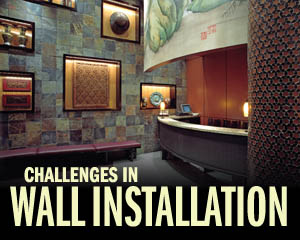Challenges in Wall Installation

Installing wall tile, whether ceramic, porcelain or natural stone, can be challenging. Keeping up with the latest in products, while remembering important application fundamentals, will help produce consistently successful-and profitable-wall tile installations. Installers face a variety of challenges with wall tile. Here are some common areas of concern:
- Gravity is the primary challenge. The weight of some tiles can cause sagging or slippage during installation.
- Having a plumb substrate is critical. The maximum variation for ceramic tile installation, as prescribed by the American National Standards Institute A108, is 1/4-inch in 10 feet and 1/16-inch in 1 foot. For natural stone tile, the "Dimension Stone Design Manual, Version 6" requires a maximum variation of 1/8-inch in 10 feet. "Lippage"-a condition where one edge of a tile is higher than adjacent edges-can occur if these tolerances aren't met. Wall installation lippage can be an aesthetic concern.
- Secure bonding is key to the success of a wall installation. The failure of a heavy tile to adhere to a wall can be a safety issue.

Solutions from mortars and mastics
Mortars and mastics are the main types of wall tile installation materials. Each has specific characteristics that must be considered when selecting an ideal solution.Latex-modified thinset mortars offer excellent adhesion and water resistance. This makes them a good choice for exterior installations or tiles that are exposed to moisture. These mortars traditionally require the use of bracing or temporary holding devices to prevent the tile from sagging or slipping during installation. Holding devices are effective but can make installation a slow-going process.

A new advanced mortar type, called performance mortar, addresses installation issues related to non-sag and other thinset mortars. These products provide a quick "grab" of tile weighing up to 6 pounds per square foot, thus eliminating the need for bracing. Some performance mortars are formulated with hollow, ceramic microspheres that produce a ball-bearing effect resulting in minimal trowel resistance and less tile-setter fatigue. Performance mortars also require no additives or extra mixing time and may be used with waterproofing membranes.
Mastics are another common setting material, particularly for indoor, residential applications. They require no mixing, and provide quick grab and minimal waste, which makes them an easy-to-use solution.

Until recently, mastics have been well suited for smaller tile sizes. But, slip resistance has greatly increased with the latest formulations. Some of these improved mastics are capable of bonding large format tile that weighs up to 7 pounds per square foot.

Getting a plumb wall before installation
Patching compounds are recommended for correcting small, uneven wall areas. The use of patching products from the same manufacturer will ensure compatibility. If a larger correction is needed, the wall can be "mudded" with metal lath covered by a scratch coat and a brown coat to give it a new flat, level surface.In addition, a 6-foot level or a 10-foot straight edge is a valuable tool to measure possible variation in the wall substrate.
Regardless of the type of correction, it is very difficult to correct out-of-plumb walls with mortar or mastic. Corrections must be made before tile installation begins.

Bonding
Ceramic tile requires a minimum of 80 percent coverage of the setting material to achieve an adequate bond. The coverage rate increases to 95 percent for ceramic tile used in exterior or shower installations. For natural stone, 100 percent coverage is recommended by the industry.Back buttering each piece of tile is a long-standing installation practice. While usually effective at attaining 100 percent coverage, it is time consuming and requires extra mortar.
The new performance mortars use a special combination of very fine particles (or nanostructures) and micropheres. This formulation makes it possible to achieve excellent coverage without applying additional material and with the right synergy of the particles creating stronger bonds with the cement.
Regardless of the bonding material being used, the best way to promote contact with the substrate is to spread the material with the flat side of the trowel. Then, the material should be combed straight with the notched side to attain maximum coverage. The tiles should then be pressed and moved perpendicular to the trowel marks. It is always a good idea to periodically remove a tile to verify coverage.
If you read this article, please circle number 339.
Sidebar: Finding help
If you need help, manufacturers of installation products are a ready source of information. They are the first and best resource for installation techniques used with proprietary products.
For more general information concerning installation specifications, look into these resources:
- The Tile Council of North America issues the "Handbook for Ceramic Tile Installation." The council also publishes the "ANSI American National Standard Specifications for the Installation of Ceramic Tile." More information about TCNA publications is available at www.tileusa.com.
- "The Dimension Stone Design Manual," published by the Marble Institute of America, is a valuable reference for anyone who installs natural stone. The MIA Web site (www.marble-institute.com) also includes white papers and other helpful resources.
Links
Looking for a reprint of this article?
From high-res PDFs to custom plaques, order your copy today!


